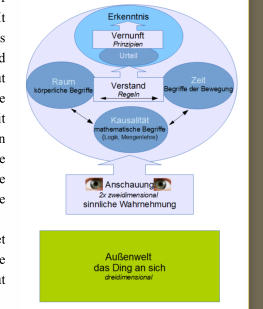








A Muggle’s Bibliothek

last
revision:
12/18/2023
16/2021

A Muggle’s Bibliothek

© Dr. Ing. Dipl Phys. M. Hüfner 2014

Limits of scientific knowledge
in the light of Kant's theory of knowledge
The theoretical physics would have believe us that there are no limits of scientific knowledge for them. It draws from mathematical models the knowledge which it generated about the world of ideas, without any account of whether these models can be true and whether it can attract more knowledge than you have put into this models. The philosophical question is: Are synthetic judgements in principle true? In other words, is it possible to get knowledge about the world on the basis of pure thought without observation?The Kantian knowledge model
250 years ago Immanuel Kant began to think about the limits of knowledge and thinking he did it so thoroughly that there is probably no one who could do better today. He put down these thoughts in his major work " Critique of Pure Reason ". Kant saw that the mind could not function as an empty container that simply receives data from the outside. Yet there must be something to arrange the incoming data. Images of external objects have to kept in the same order in which they were received. This order created by the intuition of space and time . From these considerations, he developed a model of knowledge that one can map in broad terms with the adjacent graph. Kant realized that we never have direct experience of things, the noumenal world, and what we do experience is the phenomenal world as conveyed by our senses. Since we are "visual animals", most of the information is perceived through the sense of sight , he used the term "intuition". „Experience without theory is blind, but theory without experience is mere intellectual play.“ and „All our knowledge begins with the senses, proceeds then to the understanding, and ends with reason. There is nothing higher than reason.” Immanuel Kant About " the thing in itself " we can know only as much as it allows our senses services over the imaging process. Of course, we have extremely strengthened this sense of performance since Kant's time through technical means. Nevertheless, they still have limitations. We can't see into the interior of an atom and we only can insofar see how we received with our telescopes light in the universe. We knew nothing about the backside of the moon , if we had not sent any cameras there. The same goes for all the other planets. According to Kant, the mind has a number of categories with concepts a priori, by means of which it forms judgements about rules from the experience that can be draw from "manifolds" of sensual pictures. In addition to space and time he has a panel of other categories set up, the main being the causality for linking of terms. The "a priori " can only be understood in such a way that we need it before we think with them, because of course everyone has to learn in his life terms only, only the logical combination of different sensory impressions is innate. Such a logical combination of a term with another is a relation. But the linking of sensations with one another and of sensations of terms can the brain.


From the epilogue by M. Hüfner


The physical world view between reality and surrealism










last revision: 01/16/2023

Muggle’s Library

© Dr. Ing. Dipl Phys. M. Hüfner 2014
Limits of scientific knowledge
in the light of Kant's theory of knowledge
The theoretical physics would have believe us that there are no limits of scientific knowledge for them. It draws from mathematical models the knowledge which it generated about the world of ideas, without any account of whether these models can be true and whether it can attract more knowledge than you have put into this models. The philosophical question is: Are synthetic judgements in principle true? In other words, is it possible to get knowledge about the world on the basis of pure thought without observation?The Kantian knowledge model
250 years ago Immanuel Kant began to think about the limits of knowledge and thinking he did it so thoroughly that there is probably no one who could do better today. He put down these thoughts in his major work " Critique of Pure Reason ". Kant saw that the mind could not function as an empty container that simply receives data from the outside. Yet there must be something to arrange the incoming data. Images of external objects have to kept in the same order in which they were received. This order created by the intuition of space and time . From these considerations, he developed a model of knowledge that one can map in broad terms with the adjacent graph. Kant realized that we never have direct experience of things, the noumenal world, and what we do experience is the phenomenal world as conveyed by our senses. Since we are "visual animals", most of the information is perceived through the sense of sight , he used the term "intuition". „Experience without theory is blind, but theory without experience is mere intellectual play.“ and „All our knowledge begins with the senses, proceeds then to the understanding, and ends with reason. There is nothing higher than reason.” Immanuel Kant About " the thing in itself " we can know only as much as it allows our senses services over the imaging process. Of course, we have extremely strengthened this sense of performance since Kant's time through technical means. Nevertheless, they still have limitations. We can't see into the interior of an atom and we only can insofar see how we received with our telescopes light in the universe. We knew nothing about the backside of the moon , if we had not sent any cameras there. The same goes for all the other planets. According to Kant, the mind has a number of categories with concepts a priori, by means of which it forms judgements about rules from the experience that can be draw from "manifolds" of sensual pictures. In addition to space and time he has a panel of other categories set up, the main being the causality for linking of terms. The "a priori " can only be understood in such a way that we need it before we think with them, because of course everyone has to learn in his life terms only, only the logical combination of different sensory impressions is innate. Such a logical combination of a term with another is a relation. But the linking of sensations with one another and of sensations of terms can the brain.


From the epilogue by M. Hüfner




























